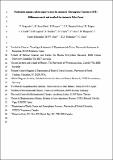Por favor, use este identificador para citar o enlazar a este item:
http://hdl.handle.net/10261/306286COMPARTIR / EXPORTAR:
 SHARE SHARE
 CORE
BASE CORE
BASE
|
|
| Visualizar otros formatos: MARC | Dublin Core | RDF | ORE | MODS | METS | DIDL | DATACITE | |

| Título: | Particulate organic carbon export across the antarctic circumpolar current at 10°e: differences between north and south of the antarctic polar front |
Autor: | Puigcorbé, Viena CSIC ORCID; Roca-Martí, Montserrat; Masqué, Pere CSIC ORCID; Benítez-Nelson, Claudia; van der Loeff, Michiel Rutgers; Laglera, Luis M. CSIC ORCID; Bracher, Astrid; Cheah, Wee; Strass, Volker; Hoppema, Mario; Santos-Echeandía, Juan CSIC ORCID CVN; Hunt, Brian P. V.; Pakhomov, Evgeny A.; Klaas, Christine | Palabras clave: | Particulate organic carbon export Thorium Southern Ocean Antarctic Circumpolar Current Polar Front Export efficiency Transfer efficiency Plankton community |
Fecha de publicación: | 2017 | Editor: | Elsevier | Citación: | Deep Sea Research - Part II - Topical Studies in Oceanography 138: 86-101 (2017) | Resumen: | The vertical distribution of 234Th was measured along the 10°E meridian between 44°S and 53°S in the Antarctic Circumpolar Current (ACC) during the austral summer of 2012. The overarching goal of this work was to estimate particulate organic carbon (POC) export across three fronts: the Sub-Antarctic Front (SAF), the Antarctic Polar Front (APF) and the Southern Polar Front (SPF). Steady state export fluxes of 234Th in the upper 100 m ranged from 1600 to 2600 dpm m−2 d−1, decreasing with increasing latitude. Using large particle (>53 μm) C/234Th ratios, the 234Th-derived POC fluxes at 100 m ranged from 25 to 41 mmol C m−2 d−1. Observed C/234Th ratios decreased with increasing depth north of the APF while south of the APF, ratios remained similar or even increased with depth. These changes in C/234Th ratios are likely due to differences in the food web. Indeed, satellite images, together with macronutrients and dissolved iron concentrations suggest two different planktonic community structures north and south of the APF. Our results indicate that higher ratios of POC flux at 100 m to primary production occurred in nanophytoplankton dominated surface waters, where primary production rates were lower. Satellite images prior to the expedition suggest that the higher export efficiencies obtained in the northern half of the transect may be the result of the decoupling between production and export (Buesseler 1998). Transfer efficiencies to 400 m, i.e. the fraction of exported POC that reached 400 m, were found to be higher south of the APF, where diatoms were dominant and salps largely abundant. This suggests different remineralization pathways of sinking particles, influencing the transfer efficiency of exported POC to depth. | Descripción: | 16 pages, 7 figures, 4 tables | Versión del editor: | https://doi.org/10.1016/j.dsr2.2016.05.016 | URI: | http://hdl.handle.net/10261/306286 | DOI: | 10.1016/j.dsr2.2016.05.016 | ISSN: | 0967-0645 | E-ISSN: | 1879-0100 |
| Aparece en las colecciones: | (IIM) Artículos (IEO) Artículos |
Ficheros en este ítem:
| Fichero | Descripción | Tamaño | Formato | |
|---|---|---|---|---|
| Puigcorbe2017_1.pdf | 406,38 kB | Adobe PDF |  Visualizar/Abrir |
CORE Recommender
SCOPUSTM
Citations
18
checked on 26-abr-2024
WEB OF SCIENCETM
Citations
19
checked on 25-feb-2024
Page view(s)
41
checked on 28-abr-2024
Download(s)
10
checked on 28-abr-2024
Google ScholarTM
Check
Altmetric
Altmetric
NOTA: Los ítems de Digital.CSIC están protegidos por copyright, con todos los derechos reservados, a menos que se indique lo contrario.
